

Doc 10
FOI 24-43
Environmental Impact Assessment Process for
Changes to Aircraft Operations
AA-NOS-ENV-2.100
Version 7
Effective 17 October 2014
Prepared: s47F
Environmental Systems Manager
Endorsed: s47F
Manager Strategy, Systems and Analysis
Authorised: s47F
Executive General Manager, Safety
Environment and Assurance
by Airservices Australia pursuant to the Freedom of Information Act 1982 (Cth)
Released
Uncontrolled if printed
© Airservices Australia 2014
1 of 35
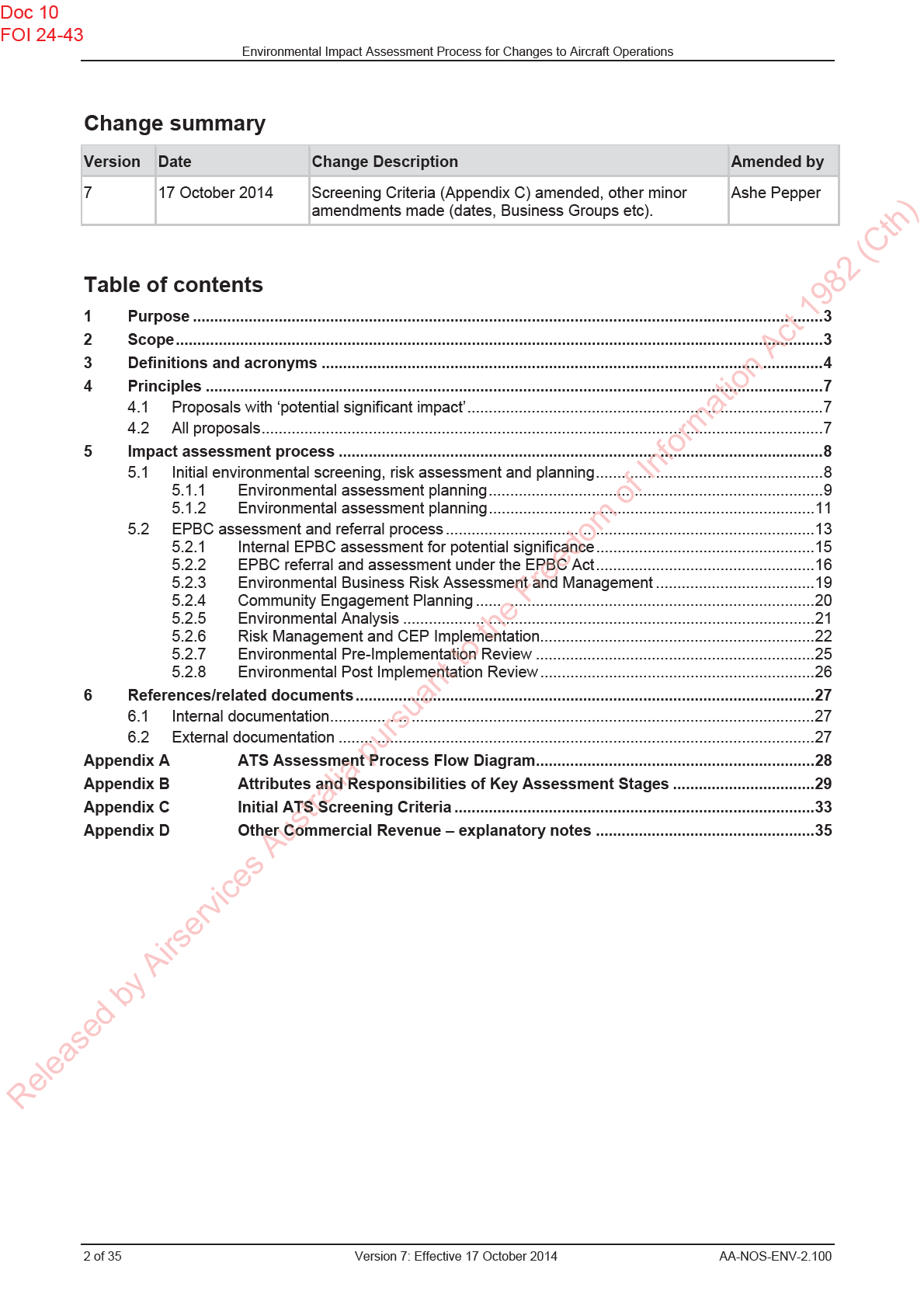
Doc 10
FOI 24-43
Environmental Impact Assessment Process for Changes to Aircraft Operations
1
Purpose
The purpose of this National Operating Standard (NOS) is to prescribe an
environmental impact assessment process (the Assessment) that must be undertaken
by Airservices, prior to the implementation of changes to aircraft operations.
The main goals of the Assessment are to:
•
meet Airservices’ Legislative obligations to:
◦
minimise significant environmental impacts resulting from any action, and
ensure appropriate environmental assessments are undertaken, as
required under the
Environmental Protection and Biodiversity Conservation
Act 1999 (EPBC Act)
◦
ensure air traffic management practices are conducted in a manner that
protects the environment, as far as is practicable, as required under the
Airservices Act 1995.
•
minimise Airservices business risks by maintaining effective stakeholder
engagement and sound corporate citizenship in aircraft noise management
•
provide a standardised and rigorous approach to assessing the impacts of
changes to aircraft operations, as a demonstration of organisational due diligence
in environmental management.
The overall outcome of the Assessment will be a defined environmental risk level and
risk mitigation strategies for the proposed change, which must be either accepted or
rejected by the ATC manager accountable for the change (such as the Executive
General Manager, Service Delivery Line Manager or ATC Line Manager) and the
manager who is implementing this change (e.g. Project Manager). Consequently, it is
not the role of Environmental Specialists to accept or reject a proposal. The decision
ultimately rests with the Change Manager, who is informed by the Assessment and the
resulting risk determination
2
Scope
The Assessment applies to all Airservices proposed changes to air traffic management
practices (Proposals) that may involve a change to aircraft operations.
Proposals include, but are not limited to, the following changes:
•
A new, or amendment to an existing, instrument approach
•
A new, or amendment to an existing, flight path or air route
•
Re-classification of airspace
•
Change to preferred runways
•
Change in time of day of operation (e.g. amendments to tower hours of operation
by Airservices Australia pursuant to the Freedom of Information Act 1982 (Cth)
– the time of day that a tower operates may alter the flight path used by aircraft)
•
A change that allows use of a flight path/airspace by a different type or number of
aircraft.
Note:
A tactical decision of an air traffic controller to alter the track of an individual
Released
aircraft does not constitute a Proposal.
AA-NOS-ENV-2.100
Version 7: Effective 17 October 2014
3 of 35
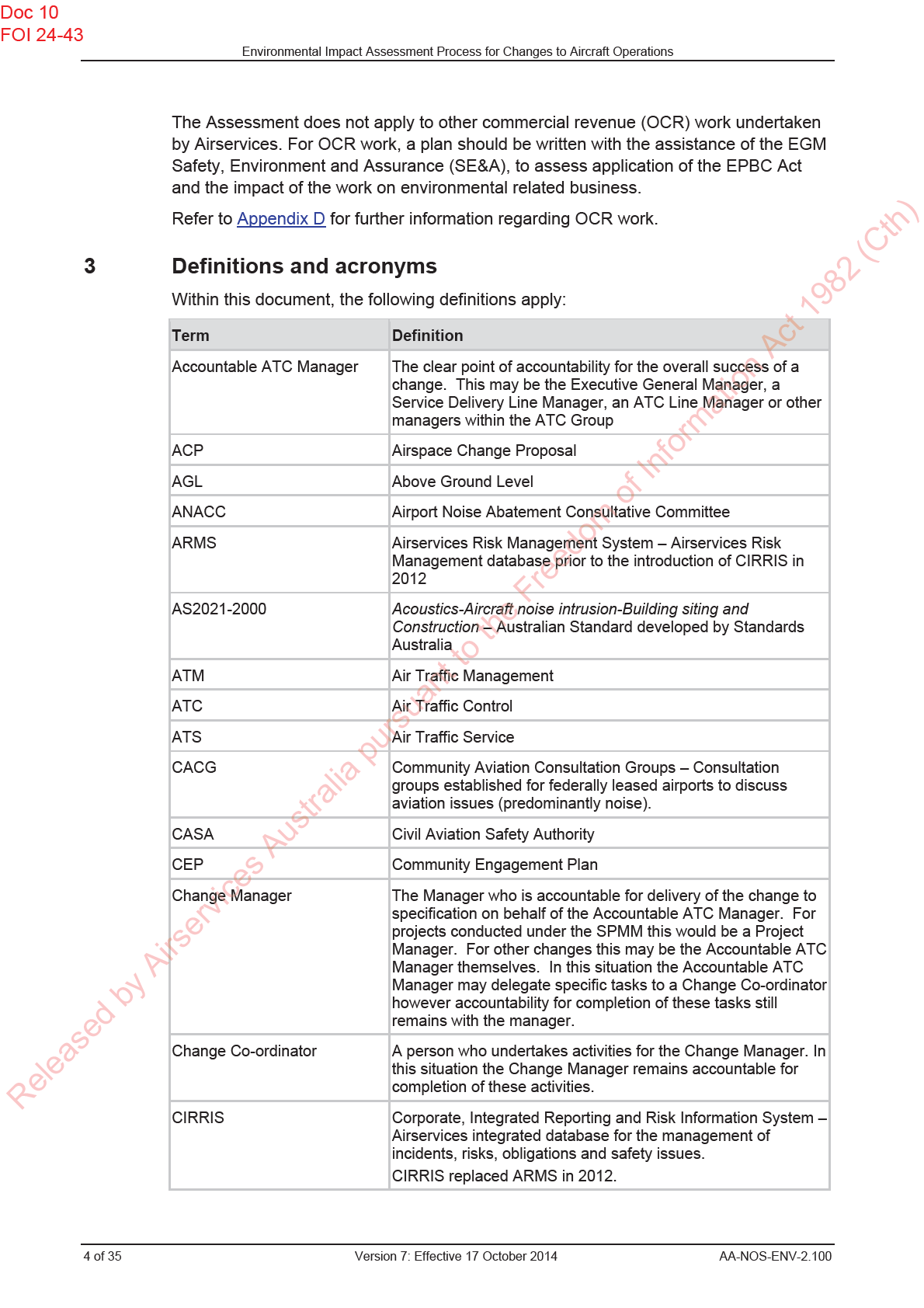
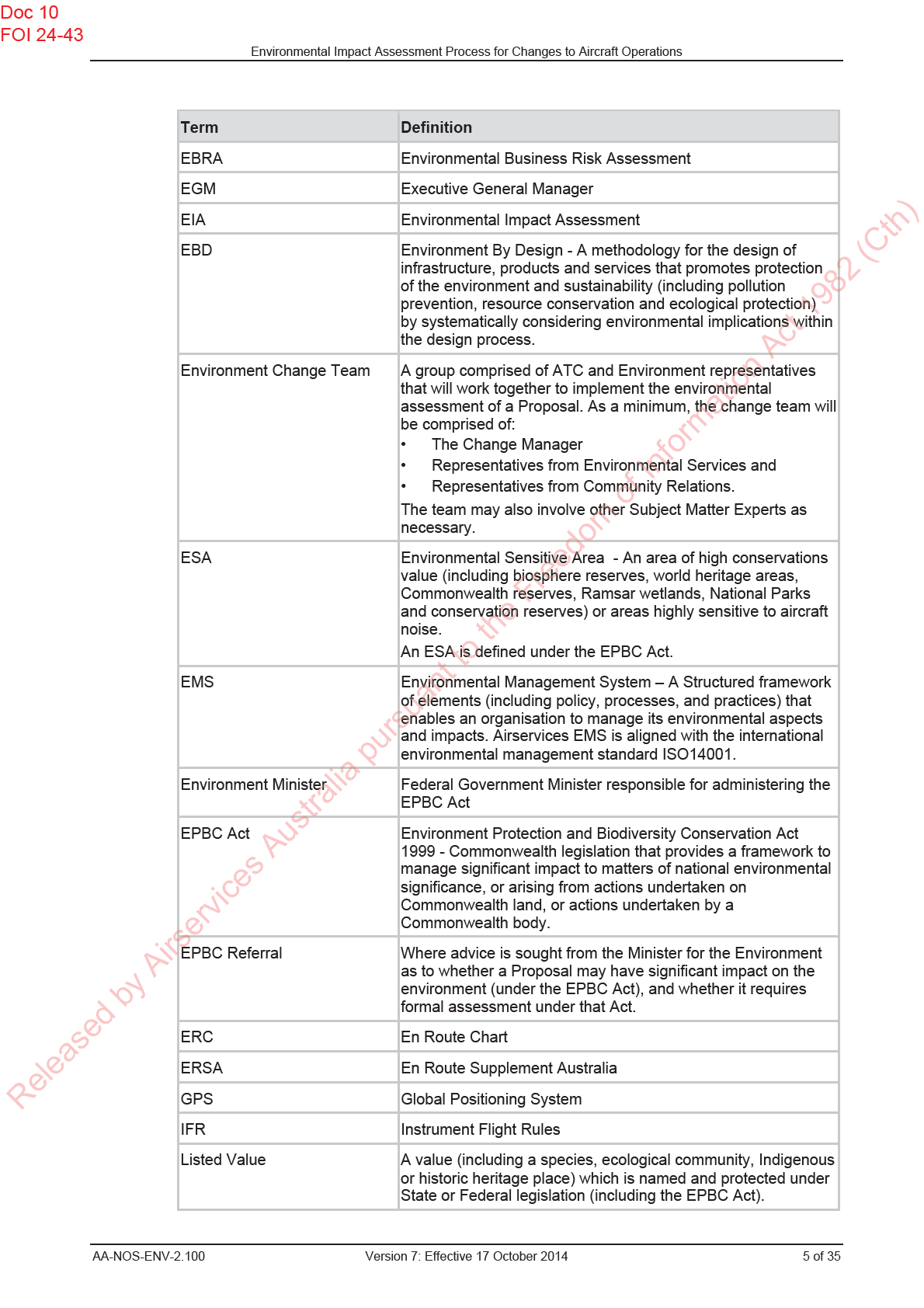
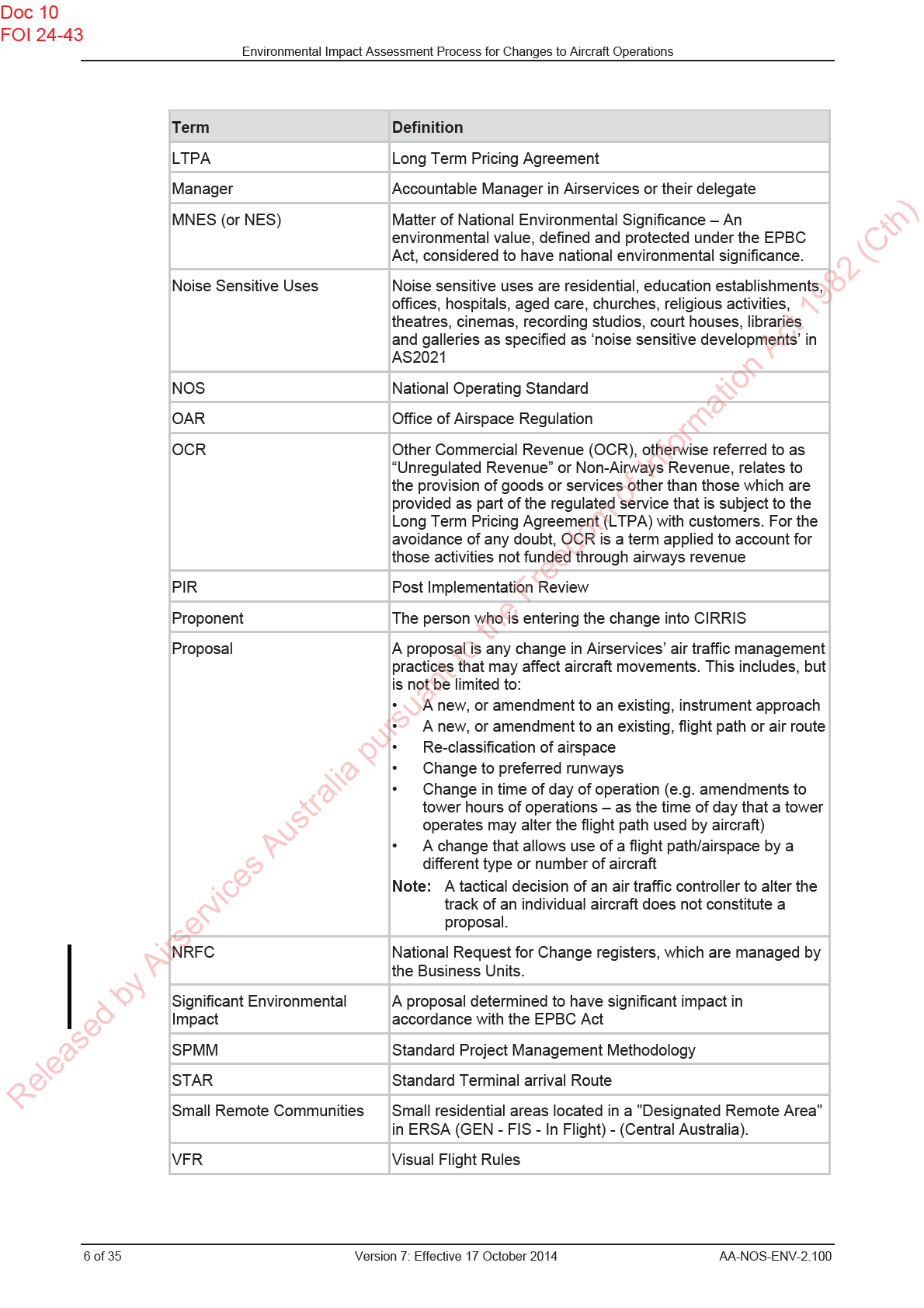
Doc 10
FOI 24-43
Environmental Impact Assessment Process for Changes to Aircraft Operations
4
Principles
4.1
Proposals with ‘potential significant impact’
Any proposal that results in an EPBC assessment finding of ‘
potential significant
impact1
’, shall be referred, by the EGM SE&A, to the Commonwealth environment
portfolio Minister (the Environment Minister) for advice, (unless the Proponent decides
not to proceed with the proposal).
Once advice is received from the Environment Minister:
•
the Environment Minister’s advice shall be considered by the CEO and
•
the action taken (e.g. in relation to implementation of the proposal) shall be
recorded, and if the Minister’s advice was not given effect, the reasons why, shall
be documented and forwarded to the Environment Minister, by the CEO, in
accordance with the EPBC Act.
4.2
All proposals
All proposed changes to Airservices’ air traffic management practices that may affect
aircraft operations shall:
•
be undertaken in accordance with this National Operating Standard (NOS) and
associated documentation
•
be recorded in CIRRIS2 and Airservices National Request for Change (NRFC)
register by the Change Manager3
•
be reassessed prior to implementation, if the proposal has already been impact
assessed in accordance with this NOS and:
◦
has subsequently been modified or
◦
over twelve months has elapsed since the initial assessment process.
by Airservices Australia pursuant to the Freedom of Information Act 1982 (Cth)
1 It is Airservices position that an Airservices EPBC noise assessment should rarely result in a finding of ‘significant
impact’ (as defined under the EPBC Act) as this is a decision that only the Environment Minister can make following their
formal assessment of the proposal, and any Airservices noise impacts can be readily mitigated and are non permanent.
The highest level of impact determined through the Airservices assessment should be a finding of ‘potential significant
Released
impact’. The final decision on actual significance (under the EPBC Act) will rest with the Environment Minister after
formal advice is sought, and any required assessments are undertaken.
2 CIRRIS replaced the ARMs database in 2012
3 Throughout the document, where accountabilities are assigned to the Change Manager, these activities can be
undertaken by delegates (such as a Change Coordinator), however the accountability to completion remains with the
Change Manager.
AA-NOS-ENV-2.100
Version 7: Effective 17 October 2014
7 of 35
Doc 10
FOI 24-43
Environmental Impact Assessment Process for Changes to Aircraft Operations
5
Impact assessment process
The Assessment is a staged process with defined ‘gates’ that must be passed through
prior to Proposal implementation. There are three main elements of the Assessment as
follows:
•
Initial Environmental Screening, Risk Assessment and Planning
•
EPBC Assessment and Referral Process
•
Environmental Business Risk Assessment and Management.
This section describes key attributes of the above Assessment elements (including the
basis for each assessment stage, key actions, responsibilities, and outcomes). This
section should be read with reference to the Overall Assessment Process Flow
Diagram (Appendix A) although key process flows are also included within the text
where relevant. Relevant attributes of the Assessment stages are also summarised in
Appendix B.
5.1
Initial environmental screening, risk assessment and planning
These Assessment stages provide for an initial environmental impact screening by the
Proponent on behalf of the Change Manager, the formation of the environmental
change team involved in the change, and a draft risk assessment (to identify changes
with an unacceptable level of risk and to assist in planning the level of work required in
later stages).
Key steps in this stage are further described in the following subsections.
Refer to Figure 1 for a flow diagram of the Initial Environmental Screening, Risk
Assessment and Planning Element.
by Airservices Australia pursuant to the Freedom of Information Act 1982 (Cth)
Released
8 of 35
Version 7: Effective 17 October 2014
AA-NOS-ENV-2.100
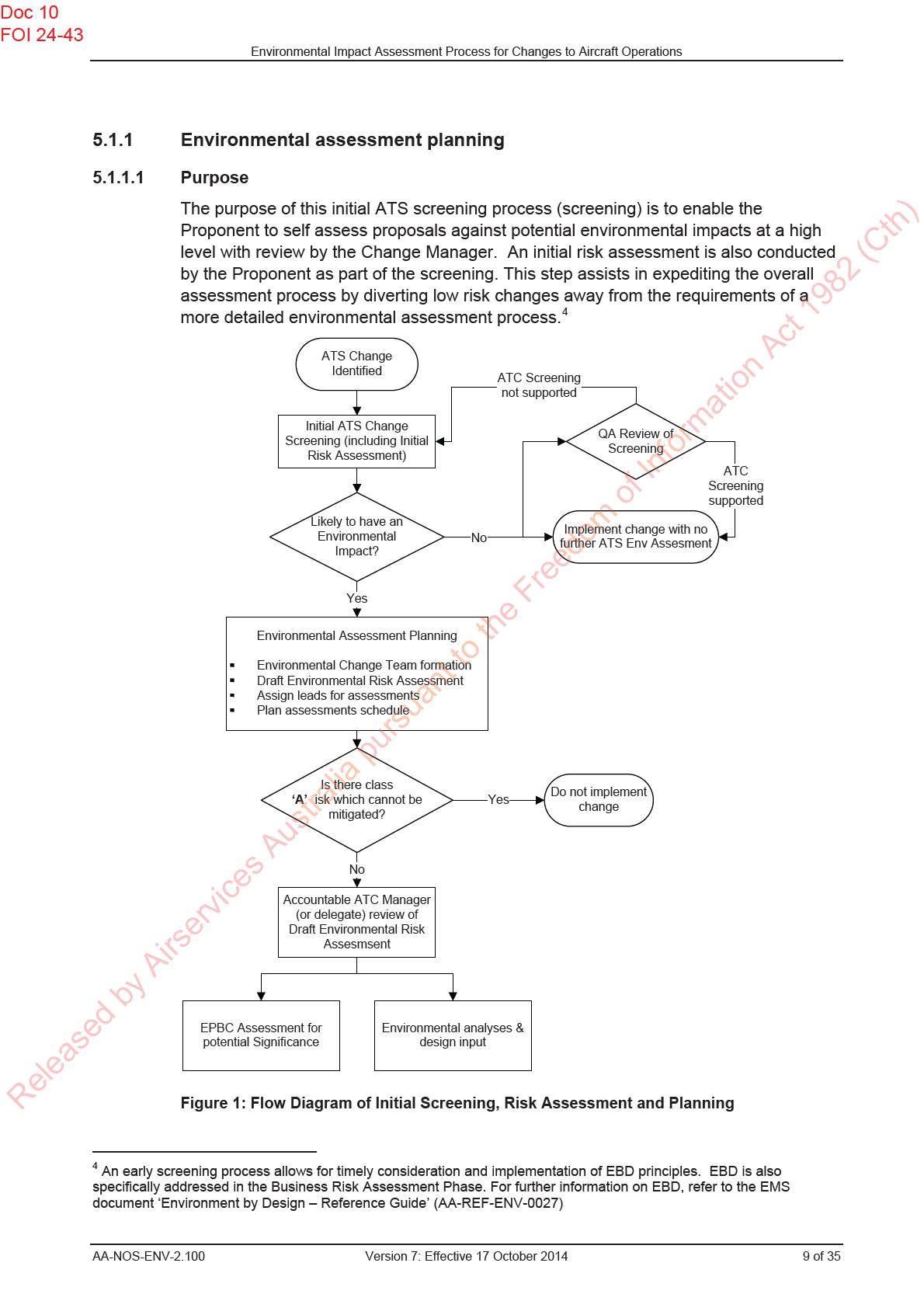
Doc 10
FOI 24-43
Environmental Impact Assessment Process for Changes to Aircraft Operations
5.1.1.2 Assessment
basis
Screening must be undertaken for all changes within the scope of this standard and is
the first step in the Assessment.
Screening considers a range of pre defined criteria that relate primarily to aircraft flight
patterns (including location, altitude and communities over-flown). The screening
criteria is included in Appendix C. As part of the screening an Initial Risk Assessment is
also conducted.
If the Screening result is:
•
TRUE for any criteria then further environmental assessment is not required.
•
FALSE for all criteria then further environmental assessments are required as
documented in this standard.
Screening is undertaken in CIRRIS and the outcome will determine whether the
change can proceed or if further environmental assessment must be conducted as part
of the change.
The Environmental Services branch perform a quality assurance review of findings
requiring no further environmental assessment, however the change can be
implemented without this QA review being completed. If, during QA review, the
assessment is believed to be incorrect, the change should not proceed without
rescreening. If the change has already been implemented, then the Accountable ATC
Manager (or delegate) will be informed and will determine if the associated risk level is
acceptable (or if further assessments and/or changes are required).
5.1.1.3 Required
Actions
The Proponent shall:
•
enter the proposal into CIRRIS and the Airservices’ NRFC register
•
undertake the Screening for Environmental Impact (using the environmental
impact screening criteria – Appendix C) for all proposals in CIRRIS
•
once reviewed by the Change Manager, record in the NRFC (and where
appropriate ARP), the screening result (including whether further Environmental
Assessment is required).
The Change Manager shall:
•
review the Screening for Environmental Impact in CIRRIS
•
inform Environmental Services (through CIRRIS) of the outcome
•
where required, seek advice from Environmental Services Branch about the
screening process.
The Environment Services Branch shall:
by Airservices Australia pursuant to the Freedom of Information Act 1982 (Cth)
•
for outcomes where no further environmental assessment is required:
◦
conduct a quality assurance review of the Proponent’s determination
against the Screening criteria (Appendix C) and any known environmental
sensitivities (without detailed analysis at this stage)
Released
◦
notify the Change Manager where the screening outcome is not supported.
10 of 35
Version 7: Effective 17 October 2014
AA-NOS-ENV-2.100
Doc 10
FOI 24-43
Environmental Impact Assessment Process for Changes to Aircraft Operations
5.1.1.4
Outcomes of Initial ATS change screening stage
•
A screening result as to whether further environmental assessment is required.
•
If no further environmental assessment is required then the change can continue
without any other assessment defined in this standard.
•
If further environmental assessment is required, then the ‘Environmental
Assessment and Planning’ stage must be conducted.
5.1.2
Environmental assessment planning
5.1.2.1 Purpose
The purpose of the Environmental Assessment Planning stage is to:
•
form the Environmental Change Team who will be involved in the change (and
will work together throughout further stages of the environmental assessment
process)
•
conduct a risk assessment to identify changes with an unacceptable level of risk
and assist in determining the level of work that needs to be undertaken in
environmental analysis and environmental risk mitigation
•
plan the remaining assessment activity
Refer to Figure 1 for a flow diagram of the Environmental Assessment and Planning
process.
5.1.2.2 Assessment
Basis
The Change Manager (or delegate) shall contact Environmental Services branch and
Community Relations branch to identify representatives to be part of the Environmental
Change Team which as a minimum shall be comprised of:
•
The Change Manager
•
Representatives from Environmental Services and
•
Representatives from Community Relations.
The team may also involve other Subject Matter Experts as necessary.
On formation of the environmental change team, the Proposal, required assessment
and community engagement will be discussed and planned (including defining and
assigning key roles, scheduling progress meetings, and setting milestones and
deliverable dates). Regular meetings should be conducted throughout the Assessment
to track progress against milestones.
As part of planning, a draft risk assessment shall be conducted by the team to
determine if the change constitutes a ‘Class A’ risk which cannot be mitigated and to
assess the amount of risk mitigation work required for other risks.
by Airservices Australia pursuant to the Freedom of Information Act 1982 (Cth)
The risk assessment will consider the following key areas:
• Community
Noise
Impact
• Aircraft
Emissions
Released
•
Other environmental impacts (including impacts to wildlife species/communities
and habitats, and social and heritage considerations).
AA-NOS-ENV-2.100
Version 7: Effective 17 October 2014
11 of 35
Doc 10
FOI 24-43
Environmental Impact Assessment Process for Changes to Aircraft Operations
The risk assessment will be based on high level considerations of known risk factors
only (e.g. sensitivities described in existing Airport Noise Risk Assessments, fuel use
thresholds, listed endangered habitats overflown, etc) and will be undertaken in
accordance with the Environmental Risk Management Standard. Only limited (non
technical) risk analysis is undertaken at this stage with no detailed environmental
analysis being undertaken.
Changes deemed to constitute a Class A risk which cannot be mitigated shall not
proceed5 and will be diverted from the Assessment process for reconsideration of
scope. The planned level of environmental analysis and environmental risk mitigation
should take in to account the risk level of the change.
Prior to proceeding to further stages of the Assessment, the draft environmental risk
assessment should be reviewed by the Accountable ATC Manager (or delegate). Risk
acceptance does not occur at this phase of the Assessment.
5.1.2.3 Required
Actions
The Change Manager (or delegate) shall:
•
contact Environment Services Branch6 and Community Relations Branch to
establish the Environmental Change Team
•
clarify the relevant proposal change details (where known), including proposed
flight path, estimated flight numbers, deadline for implementation of proposed
change etc7
•
not proceed with proposals deemed to have a Class ‘A’ Risk which cannot be
mitigated (unless the change is redesigned and reassessed or authorised by the
CEO)
•
facilitate review of the draft environmental risk assessment by the Accountable
ATC Manager
•
ensure the Accountable ATC Manager’s comments are captured within the draft
environmental risk assessment.
The Environmental Change Team shall:
•
agree the composition of the environmental change team
•
agree the assessment process (including key roles, progress meeting schedule,
milestones and deliverable dates)
•
throughout the entire process, adhere to the change schedule and defined
milestones and advise other parties in the environmental change team well in
advance if delays to agreed deliverables are likely
•
throughout the entire process, attend planning meetings and participate in the
risk assessment process
•
agree risk assessment findings.
by Airservices Australia pursuant to the Freedom of Information Act 1982 (Cth)
Released
5 As per Airservices Risk Management Framework, activities assessed as constituting a Class A risk are not permitted
(unless otherwise authorised by the CEO in exceptional circumstances).
6 Through the Assessments and Programs Manager, Environment Group
7 This reduces undue reliance on assumptions during and the Assessment and ensures appropriate authority for access
to change information.
12 of 35
Version 7: Effective 17 October 2014
AA-NOS-ENV-2.100
Doc 10
FOI 24-43
Environmental Impact Assessment Process for Changes to Aircraft Operations
The Environmental Services Branch shall:
•
lead the initial environmental risk assessment (using the Airservices Risk
Management Standard AA-NOS-RISK-0001, and Environmental Risk
Management Procedure AA-PROC-SAF-0105) with respect to the key areas of:
◦ Community
Noise
Impact
◦ Emissions
Impacts
◦
Other environmental impacts (including impacts to wildlife
species/communities and habitats, and social and heritage considerations)
•
ensure appropriate involvement by the Change Manager, Community Relations
and Subject Matter Experts in the initial environmental risk assessment
•
enter the draft risk assessment in CIRRIS and advise the Change Manager of the
record
•
update the environmental risk assessment as requested by the Accountable ATC
Manager or Change Manager.
The Community Relations Branch shall:
•
participate in the draft environmental risk assessment and planning process to
provide guidance on Community Noise Impact and Community Engagement
Planning.
The Accountable ATC Manager (or delegate) shall:
•
review and provide comment on the Proposal and risk assessment (note that the
review must be conducted by a Manager with an appropriate level of risk
acceptance delegation). Note final risk acceptance does not occur at this stage.
5.1.2.4
Outcomes of Environmental Assessment and Planning Stage
•
The formation of an environmental change team for the proposed change
•
A defined assessment management process (including lead roles, timeframes
and meeting schedule)
•
A completed draft environmental risk assessment and agreed level of change risk
which has been reviewed by the Accountable ATC Manager (or delegate)
•
Progression to further assessment stages (i.e. EPBC Assessment and
Community Engagement Planning and Environmental Analysis).
5.2
EPBC assessment and referral process
Under the EPBC Act, actions that have, or are likely to have, a significant impact on a
matter of National Environmental Significance (NES) require approval from the
Australian Government Minister for the Environment (the Environment Minister).
In addition to the above, Section 160 of the EPBC Act, requires Commonwealth
by Airservices Australia pursuant to the Freedom of Information Act 1982 (Cth)
agencies (such as Airservices) to seek the Environment Minister's advice8 for the
adoption or implementation of a plan for aviation airspace management involving
aircraft operations that have, will have, or are likely to have a significant impact on the
environment in general (i.e. not just impacts to matters of NES).
Released
8 Under the EPBC Act, advice is sought through the preparation of an EPBC Referral.
AA-NOS-ENV-2.100
Version 7: Effective 17 October 2014
13 of 35
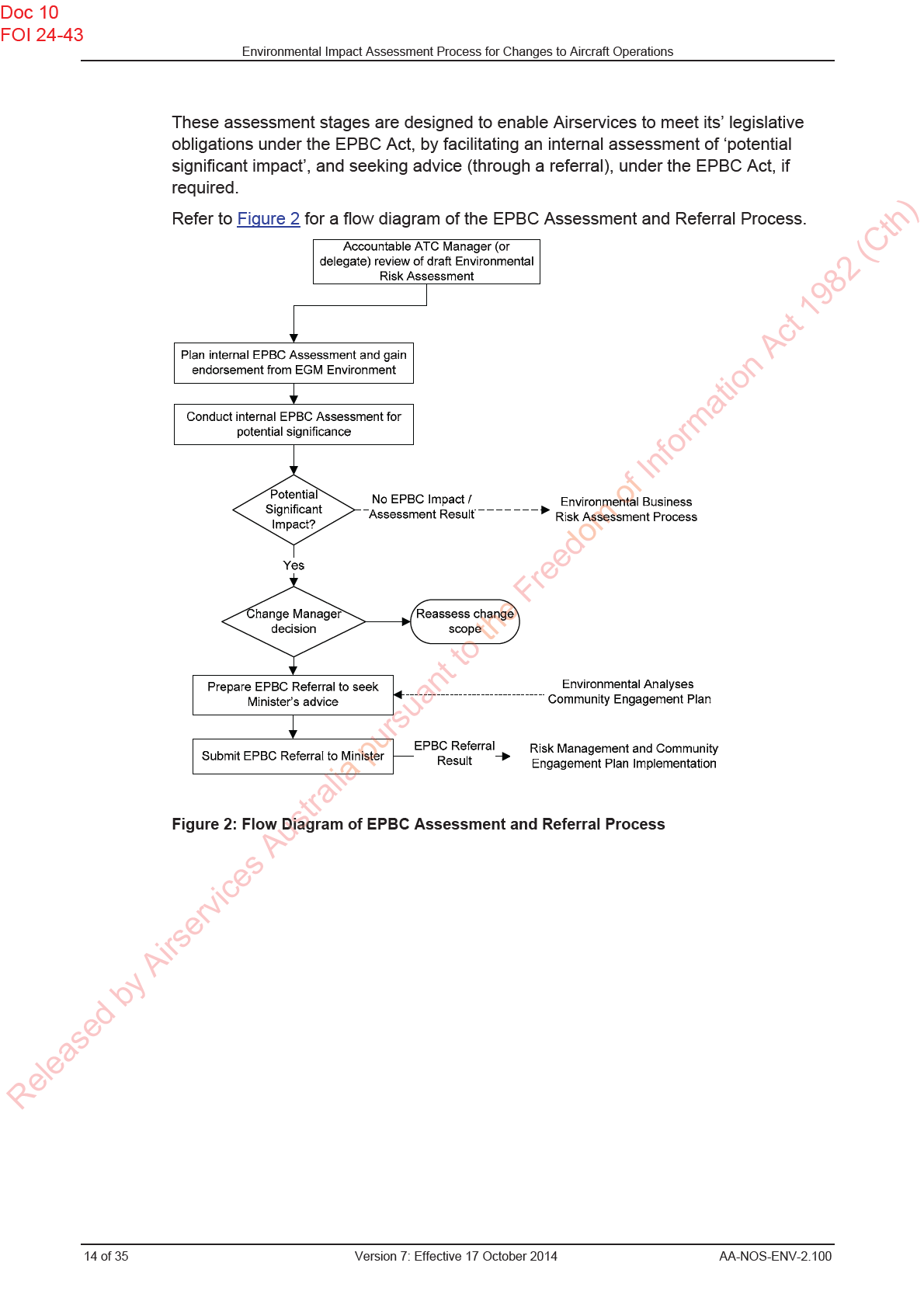
Doc 10
FOI 24-43
Environmental Impact Assessment Process for Changes to Aircraft Operations
5.2.1
Internal EPBC assessment for potential significance
5.2.1.1 Purpose
This assessment stage determines whether the change has the potential to cause
significant impact to the environment, and if it therefore warrants advice from the
Environment Minister through a referral process in accordance with the EPBC Act.
5.2.1.2
Basis of the assessment
The internal EPBC impact assessment will be undertaken by the Environmental
Services Branch who will assess the change based on defined assessment criteria.
For all changes, the internal EPBC assessment criteria for potential significance shall
be endorsed by the EGM Environment prior to commencement of the assessment.
Airservices internal EPBC assessment criteria shall:
•
define standardised significant impact measures and thresholds which, if
reached, result in a finding of ‘potentially significant’9. Use of standardised
measures and thresholds shall minimise the potential for subjectivity within the
EPBC assessment process;
•
considers noise impacts on communities as well as impacts to a range of
environmental values and is aligned with the ‘Actions on, or impacting upon,
Commonwealth land, and actions by Commonwealth Agencies, Significant
Impact Guideline 1.2’ (Commonwealth of Australia 2010).
A Proposal must be redesigned, or referred for assessment under the EPBC Act, any
change assessed as having ‘potential significant impact’.
5.2.1.3 Required
Actions
The Change Manager (or delegate) shall:
•
Provide all relevant Proposal details (including flight paths, flight frequencies,
flight numbers, aircraft types etc), required to make the assessment, in
accordance with agreed project timelines
•
accept that when a decision of ‘potential significant impact’ is reached, then the
Proposal cannot proceed as planned without being referred to the Environment
Minister
•
in consultation with the Accountable ATC Manager, make a decision on whether
to proceed with the Proposal as planned, or whether to redesign and reassess
the Proposal (based on the Assessment findings).
by Airservices Australia pursuant to the Freedom of Information Act 1982 (Cth)
Released
9 Note that the assessment should rarely result in a finding of ‘significant impact’ as it is Airservices position that this is a
determination that only the Federal Environment Minister can make through advice sought by Airservices and following
formal assessment under the EPBC Act. Further, the reversible nature of Aircraft operations is not consistent with the
notion of ‘significant impact’.
AA-NOS-ENV-2.100
Version 7: Effective 17 October 2014
15 of 35
Doc 10
FOI 24-43
Environmental Impact Assessment Process for Changes to Aircraft Operations
The Environmental Services Branch shall:
•
define the EPBC significance criteria and assessment methodology for the
change and seek endorsement of the approach from the EGM SE&A
•
provide the Environment Change Team with an indicative program for completion
of necessary environmental assessments
•
undertake and manage the Assessment, and make a recommendation with
respect to potential significance, using the predefined EPBC significance criteria
and assessment methodology
•
produce a report that documents the assessment and findings
•
enter the outcomes of the assessment in CIRRIS.
The EGM SE&A shall:
•
endorse the EPBC significance criteria and assessment methodology for the
change
•
accept or reject any finding regarding potential environmental significance.
5.2.1.4 Outcomes
•
A decision on whether or not the Proposal is likely to result in ‘potential significant
impact’ environmental impacts if implemented as planned
•
If the Proposal is deemed
NOT to constitute ‘potential significant impact’:
◦
Continuation of the Environmental Business Risk Assessment and
Management stages (informed by the EPBC Assessment result).
•
If the Proposal is deemed ‘potentially significant’ by Airservices:
◦
A decision from the Change Manager (in consultation with the Accountable
ATC Manager) on whether to proceed with the Proposal as planned (i.e.
whether to submit a referral under the EPBC Act)
◦
Progression to the EPBC Referral and Assessment stage if the Proponent
decides to proceed with the Proposal as planned.
5.2.2
EPBC referral and assessment under the EPBC Act
5.2.2.1 Purpose
The purpose of this stage is to seek advice (through a referral) from the Minister
regarding whether a Proposal constitutes ‘significant impact’ under the EPBC Act, and
if so, to have the Proposal formally assessed.
This is required for all Proposals which have met the criteria for ‘potential significant
impact’ under the Assessment, and where the Proponent has decided to proceed with
the Proposal as planned.
by Airservices Australia pursuant to the Freedom of Information Act 1982 (Cth)
5 2.2.2 Assessment
basis
Proposals determined to have ‘potential significant impact’ are ‘referred’ to the
Environment Minister for advice as to whether the Proposal warrants formal
assessment under the EPBC Act. This is known as an ‘EPBC Referral’.
Released
EPBC Referrals must describe the Proposal (including Proposal details, existing
environment and potential impacts) and are required to be submitted in the approved
form (a template is provided on the Department of Environment website). The
16 of 35
Version 7: Effective 17 October 2014
AA-NOS-ENV-2.100
Doc 10
FOI 24-43
Environmental Impact Assessment Process for Changes to Aircraft Operations
Environment Minister must assess the referral and provide advice within 20 business
days.
Following assessment of a referral, the Minister can make one of three decisions as
follows:
•
Controlled action – Action is subject to the assessment and approval
process under the EPBC Act, as the Proposal is deemed likely to cause
significant impact
•
Not controlled action (‘particular manner’) - approval is not required if the
action is taken in accordance with the manner specified
•
Not controlled action – Approval is not required if the action is taken in
accordance with the Referral.
If the Minister decides that the Proposal is likely to result in ‘significant impact’ to the
Environment (i.e. it constitutes a ‘controlled action’) then formal assessment under the
EPBC Act is required. Formal assessment may be undertaken under a range of
processes defined in the EPBC Act (as directed by the Minister) which are not
described in this document.
5.2.2.3 Required
Actions
The Environmental Change Team shall:
•
attend regular Proposal meetings and Proposal definition activities as required
(including workshops and meetings with external government departments)
•
review all required information, draft reports and correspondence, and provide
any required feedback in accordance with agreed project timelines.
The Change Manager (or delegate) shall:
•
provide all relevant Proposal details (including flight paths, flight frequencies,
flight numbers, aircraft types etc), required to prepare required assessment
documentation, in a timely manner on behalf of the Proponent.
Environmental Services shall:
•
prepare, or manage preparation of, an EPBC Referral on behalf of the Change
Manager
•
prepare, or manage preparation of, any environmental analysis documentation
required to support formal assessment under the EPBC Act (if required)
•
manage any EPBC referral and assessment processes
•
enter the outcomes of the assessment in CIRRIS.
The EGM SE&A shall:
•
endorse and provide the EPBC Referral to the Environment Minister.
by Airservices Australia pursuant to the Freedom of Information Act 1982 (Cth)
Released
AA-NOS-ENV-2.100
Version 7: Effective 17 October 2014
17 of 35
Doc 10
FOI 24-43
Environmental Impact Assessment Process for Changes to Aircraft Operations
5.2.2.4 Outcomes
•
A request for advice (i.e. an EPBC Referral) sent to the Minister by the Executive
General Manager Environment, regarding whether or not the Proposal is likely to
result in ‘significant impact’
•
Advice and/or a decision from the Environment Minister regarding whether the
Proposal constitutes ‘significant impact’ and any further assessments or actions
required under the EPBC Act (following referral of any Proposal to the Minister for
assessment)
•
If the Proposal is deemed by the Environment Minister (following referral) as
likely to have a ‘significant impact’ (i.e. constitutes a ‘controlled action’):
◦
An environmental assessment report (in whichever form specified) sent to
the Environment Minister, for formal assessment under the EPBC Act.
◦
A decision from the Minister, following review of the environmental
assessment report, regarding whether to approve the action, and what
conditions (if any) to impose.
by Airservices Australia pursuant to the Freedom of Information Act 1982 (Cth)
Released
18 of 35
Version 7: Effective 17 October 2014
AA-NOS-ENV-2.100
Doc 10
FOI 24-43
Environmental Impact Assessment Process for Changes to Aircraft Operations
5.2.3
Environmental Business Risk Assessment and Management
These Assessment stages provide for identification, assessment and management of
environmental business risks to Airservices resulting from implementation of a
Proposal. Environmental business risks are those that may not trigger Airservices
EPBC Assessment criteria, but may still represent environmental, financial and
reputational business risks for Airservices.
The Environmental Business Risk Assessment provides an additional tier of impact
assessment, which complementary to regulatory requirements and further
demonstrates due diligence in environmental management.
These Assessment stages incorporate environmental analysis of noise impacts, risk
analysis, and development of a Community Engagement Plan.
Key steps in this Assessment stage are further outlined below. While activities are
identified in a staged order, they are necessarily inter-related and iterative in nature.
Refer to Figure 3 for a flow diagram of the Environmental Business Risk Assessment
and Management Stages.
Accountable ATC Manager (or
delegate) review of Initial Environmental
Risk Assessment
No EPBC Impact /
Community
Environmental
Assessment Result
Engagement Planning
Analysis
Informs any
Referral
Risk Management and
EPBC Referral
Risk not accepted
Community Engagement
Result
by Accountable ATC Manager
Plan Implementation
Do not implement change,
reassess scope or identify
new mitigation
Environmental Pre-
Risk not accepted
Implementation Review
by Accountable ATC Manager
Change Implementation
by Airservices Australia pursuant to the Freedom of Information Act 1982 (Cth)
Post Implementation
Review
Released
Figure 3: Flow Diagram of Environmental Business Risk Assessment and Management
Process
AA-NOS-ENV-2.100
Version 7: Effective 17 October 2014
19 of 35
Doc 10
FOI 24-43
Environmental Impact Assessment Process for Changes to Aircraft Operations
5.2.4
Community Engagement Planning
5.2.4.1 Purpose
The purpose of this stage is to:
•
inform the level of, and guide the approach to, further environmental impact
analyses and change design
•
commence development of the Community Engagement Plan (CEP) which is a
significant mitigator for community noise impact.
5.2.4.2
Content and approach
Community Engagement Planning will commence following the definition of change
environmental risks (following the draft Environmental Risk Assessment, described in
Section 5.1). It is an iterative process that will continue through subsequent stages of
environmental analysis and risk assessment. Although drafting may commence, the
CEP will only be finalised on completion of all Stages of the Environmental Business
Risk Assessment (and prior to change implementation).
The CEP guides engagement and consultation with the community in line with
Airservices Communication and Consultation Protocol. The CEP will also document
the process for the Post Implementation Review (PIR) of the environmental impact of
the change.
Following the initial Environmental Risk Assessment, and based on the identified risk
levels, the level of required community engagement and consultation will be
determined. For example, more in depth community engagement will be necessary for
identified community noise impacts with a class B risk, than for those with a Class C or
D risk.
The required environmental analyses to support this community engagement will also
be based upon the necessary level of community engagement. For example, more
detailed noise impact analyses will be recommended for identified community noise
impacts with a class B risk, than for those with a class C or D.
The recommended level of community engagement, and environmental analyses to
support the planning, will be discussed and agreed with the Environmental Change
Team, prior to Community Relations and Environmental Services developing the
associated plans and conducting the analyses.
5.2.4.3 Required
Actions
The Environment Change Team shall:
•
agree the recommendations of the Community Engagement Planning stage.
The Change Manager (or delegate):
by Airservices Australia pursuant to the Freedom of Information Act 1982 (Cth)
•
Review and provide comment on the draft and final version of the CEP;
•
Accept the recommendations of the Communication and Engagement Planning
stage.
Environment Services shall:
Released
•
agree the level of further noise impact analysis to be undertaken to support
preparation of the CEP.
20 of 35
Version 7: Effective 17 October 2014
AA-NOS-ENV-2.100
Doc 10
FOI 24-43
Environmental Impact Assessment Process for Changes to Aircraft Operations
Community Relations shall:
•
manage the community engagement planning phase
•
recommend the level of Community Noise Impact Analysis to be undertaken to
support preparation of the CEP
•
ensure appropriate involvement (and where necessary signoff) from subject
matter experts (including Government and Industry Affairs) and alignment with
other stakeholder engagement plans.
5.2.4.4 Outcomes
•
Commencement of drafting of the CEP
•
A defined focus and level of Community Noise Impact Analyses to be undertaken
to support preparation of the CEP
•
An agreed level and focus of community engagement and consultation (as
documented in the CEP).
5.2.5
Environmental Analysis
5.2.5.1 Purpose
The purpose of this stage is to identify and analyse potential environmental, financial
and reputational business impacts and benefits of the change.
5.2.5.2
Assessment Basis
The Environmental Analysis stage provides additional information about the proposed
change with respect to the three key areas of potential environmental impacts (and
benefit) as follows:
• Community
Noise
Impact
• Emissions
•
Other environmental issues (including impacts to wildlife species/communities
and habitats, and social and heritage considerations).
There must be an agreement within the Environmental Change Team on the purpose
for conducting individual analyses. These may include:
•
to support refinement or optimisation of the design (including alignment with, and
incorporation of EBD principles wherever possible)
•
to support community engagement and consultation planning
•
to define potential noise or emissions benefits
•
to support an EPBC Referral (after a potential need for referral has been
identified through the EPBC Assessment Process )
•
to assist in communication or engagement with other stakeholders (e.g. Industry)
by Airservices Australia pursuant to the Freedom of Information Act 1982 (Cth)
Environmental Services will lead the analyses where appropriate but will work closely
with the Environmental Change Team throughout the process.
The level and focus of analyses will be determined by the drivers for conducting the
Released
analysis. For example, electoral boundary analysis may be conducted to support
stakeholder engagement planning where risks associated with particular demographics
or interest groups have been identified.
AA-NOS-ENV-2.100
Version 7: Effective 17 October 2014
21 of 35
Doc 10
FOI 24-43
Environmental Impact Assessment Process for Changes to Aircraft Operations
Any analysis conducted will also assist in review and update of the Environmental
Business Risk Assessment.
5.2.5.3 Required
Actions
The Environmental Change Team shall:
•
agree the level, focus and schedule of impact analyses
•
agree the resulting risk level.
The Change Manager (or delegate) shall:
•
provide all relevant Proposal details (including flight paths, flight frequencies,
flight numbers, aircraft types etc), required to make the assessment, in a timely
manner.
Community Relations shall:
•
define what analysis is required to assist with the community engagement and
consultation planning.
Environmental Services Branch shall:
•
analyse the impact using the agreed methodology and metrics
•
manage the impact analysis process (including holding meetings, managing
deadlines and milestones)
•
produce a report that documents the impact analysis and results
•
ensure appropriate involvement by the Change Manager, Community Relations
and Subject Matter Experts in the update of the environmental risk assessment
•
enter the updated risk assessment in CIRRIS and advise the Change Manager of
the record.
5.2.5.4 Outcomes
•
Documented impact analyses for the Proposal that where necessary address:
◦ Community
Noise
Impact
◦ Emissions
◦
Other environmental impacts (including impacts to wildlife species and
habitats, and social and heritage considerations).
•
Results of the analyses to assist further design work, development of a CEP,
understanding of environmental benefits, preparation of an EPBC Referral and/or
other stakeholder engagement.
•
Progression to the Risk Management and CEP Implementation Stages
5.2.6
Risk Management and CEP Implementation
by Airservices Australia pursuant to the Freedom of Information Act 1982 (Cth)
5.2.6.1 Purpose
The purpose of the Risk Management and CEP Implementation stage is to:
•
update, review and accept the level of change risks (resulting from the
Environmental Analysis and Community Engagement Planning stage)
Released
•
implement the CEP
•
update review and accept risks following implementation of the CEP to determine
whether to implement the Proposal.
22 of 35
Version 7: Effective 17 October 2014
AA-NOS-ENV-2.100
Doc 10
FOI 24-43
Environmental Impact Assessment Process for Changes to Aircraft Operations
5.2.6.2 Process
description
Risk review and acceptance
Following environmental analysis and communication planning, the environmental
business risks are updated (by Environmental Services Branch) and need to be
reviewed and accepted (or rejected) by the Accountable ATC Manager (or delegate).
Risk review at this stage will also consider any Ministerial advice or assessment
findings following any EPBC Referral or assessment processes undertaken in
accordance with the EPBC Act (as described in Section 5.2.2).
Upon risk acceptance, the proposal can proceed to the CEP implementation stage. If
the risk is not accepted the proposal must be redesigned or not pursued further. Risk
acceptance recorded in CIRRIS
Following implementation of the CEP, a further risk review and update is undertaken
based on the findings of the community engagement and consultation process. This
process captures the feedback received from the community and ensures that the risk
assessment reflects this information. On acceptance of the resulting risk, the Proposal
can be implemented (if not accepted it must be redesigned).
CEP Implementation
The CEP is implemented in accordance with the methodology it describes.
Implementation methodology will vary for each CEP (targeted to the particular
Proposal) but is likely to include:
•
a presentation to relevant community groups and bodies (e.g. Airport Community
Aviation Consultation Groups – CACGs) where the proposed change is
communicated, (including timeframes for implementation, flight paths, and likely
noise levels/associated impacts)
•
publication on the Airservices website
•
participation in other activities required by other stakeholder engagement plans
(e.g. Communication to politicians) where necessary
•
a request for comments on the intended Proposal to be provided by a specified
date.
5.2.6.3 Required
Actions
The Environment Change Team shall:
•
agree the updated risk level (pre and post CEP implementation)
•
collaborate to implement the CEP as required
•
discuss outcomes of the CEP implementation (and consultation process) and
agree any required changes to risk assessments and/or Change design
by Airservices Australia pursuant to the Freedom of Information Act 1982 (Cth)
•
agree any further environmental actions that must undertaken taken as follows:
◦
prior to implementation of the Proposal (if final risk accepted)
◦
with respect to redesign or re-assessment (if final risk is not accepted)
Released
AA-NOS-ENV-2.100
Version 7: Effective 17 October 2014
23 of 35
Doc 10
FOI 24-43
Environmental Impact Assessment Process for Changes to Aircraft Operations
The Change Manager shall:
•
facilitate review of the updated environmental risk assessment by the
Accountable ATC Manager (or delegate)
•
not proceed with proposals deemed to have a Class ‘A’ Risk which cannot be
mitigated (unless the change is redesigned and reassessed or authorised by the
CEO)
•
ensure the Accountable ATC Manager’s (or delegate’s) comments are captured
with respect to the risk review and associated decisions.
The Accountable ATC Manager (or delegate) shall:
•
review (i.e. accept or reject) and provide comment on the risk assessment
findings (note that the review must be conducted by a Manager with an
appropriate level of risk acceptance delegation)
•
risk review shall be undertaken at the following stages:
◦
after the Environmental Analysis/Community Engagement Planning stages
and risk update and
◦
following implementation of the CEP and any risk update required after the
consultation process.
Environmental Services shall:
•
update the Proposal risk level following the Environmental Analysis and
Community Engagement Planning Stages
•
participate in implementation of the CEP (as Subject Matters Experts) as required
and as agreed by the Environmental Change Team
•
update the Proposal risk level again following implementation of the CEP (and
based on consultation findings and agreement within the Environment Change
Team) and advise the Change Manager of the record
•
ensure appropriate involvement by the Change Manager, Community Relations
and Subject Matter Experts in the environmental risk assessment
•
update the environmental risk assessment as requested by the Accountable ATC
Manager or Change Manager.
Community Relations shall:
•
lead the environmental risk review and update (pre and post CEP
implementation), in collaboration with Environmental Services Branch
•
lead and manage implementation and delivery of the CEP (including all
consultation and delivery at relevant forums - including CACGs and Community
groups)
•
compile all feedback and consultation records and communicate the findings to
the Environmental Change Team
by Airservices Australia pursuant to the Freedom of Information Act 1982 (Cth)
Released
24 of 35
Version 7: Effective 17 October 2014
AA-NOS-ENV-2.100
Doc 10
FOI 24-43
Environmental Impact Assessment Process for Changes to Aircraft Operations
5.2.6.4 Outcomes
•
A revised risk assessment and agreed level of Proposal risk (either Class A, B, C,
or D) to guide implementation of the CEP
•
Implementation of the CEP to relevant stakeholders (including relevant CACGs,
other Community groups as required)
•
A revised risk assessment and agreed level of Proposal risk (either Class A, B, C,
or D) post implementation of the CEP
•
Ultimately a decision on whether or not to proceed with implementing the
Proposal (on final risk assessment) or whether redesign is necessary.
5.2.7 Environmental
Pre-Implementation Review
5.2.7.1 Purpose
The purpose of this review is to verify that the Proposal has undergone the appropriate
environmental assessment and risk management processes prior to implementation
It provides a final ‘gate’ to the Assessment to ensure compliance with this Standard
and the Airservices EMS.
5.2.7.2 Required
Actions
The Change Manager shall:
•
conduct a pre-implementation review prior to implementing any Proposal to verify
that the following has been undertaken:
◦
An Internal EPBC Assessment has been conducted
◦
Any requirements based upon the Environment Minister’s response to an
EPBC Referral have been met
◦
The CEP has been conducted and the feedback captured within the
Environmental Business Risk Assessment
◦
The final environmental risk assessment of the change has been accepted
◦
The result has been recorded in CIRRIS (and NRFC and ACP if required).
•
advise the Accountable ATC Manager of the risk acceptance status following the
Pre-Implementation review
•
not implement the Proposal until final risk acceptance has been undertaken and
recorded in CIRRIS.
5.2.7.3 Outcomes
Verification by the Change Manager that the change is acceptable for implementation
from an Environmental perspective.
by Airservices Australia pursuant to the Freedom of Information Act 1982 (Cth)
Released
AA-NOS-ENV-2.100
Version 7: Effective 17 October 2014
25 of 35
Doc 10
FOI 24-43
Environmental Impact Assessment Process for Changes to Aircraft Operations
5.2.8 Environmental
Post Implementation Review
5.2.8.1 Purpose
The purpose of the PIR is to assess implementation of the Proposal with respect to
environmental management performance against associated commitments (as
described in the CEP and any other Proposal documentation). The Environmental PIR
shall focus on Community Noise Impact. Should other Environmental Post
Implementation Review be required (e.g. emissions impact), this should be planned
separately by the environmental change team.
5.2.8.2
Assessment Basis
Following implementation of a Proposal, Community Relations will lead the PIR in
accordance with principles described in the Standard Project Management
Methodology.
Where appropriate the PIR should include an assessment of actual noise levels
received at ground level and analysis of community response (i.e. complaints).
A PIR report shall be provided to the Accountable ATC Manager and Change Manager
for acceptance. It shall also be provided to the Environment Change Team and other
relevant external parties as documented within the CEP.
5.2.8.3 Required
Actions
The Environment Change Team shall:
•
agree the schedule for the PIR
•
identify and plan separate PIR as necessary for environmental factors other than
community noise impact.
Community Relations shall:
•
document the plan for PIR within the CEP
•
conduct a PIR in accordance with the CEP
•
provide the PIR report to the Accountable ATC Manager and Change Manager
for acceptance
•
provide the PIR report to the Environment Change Team
•
provide the PIR report to external parties as documented within the CEP.
5.2.8.4 Outcomes
•
Confirmation as to whether the actual outcomes of the change met the predicted
outcomes
•
Identification of process improvements.
by Airservices Australia pursuant to the Freedom of Information Act 1982 (Cth)
Released
26 of 35
Version 7: Effective 17 October 2014
AA-NOS-ENV-2.100
Doc 10
FOI 24-43
Environmental Impact Assessment Process for Changes to Aircraft Operations
6
References/related documents
6.1
Internal documentation
•
Environment Policy - C-POL:AA 000 6
•
Environmental Risk Management National Operating Standard
•
Airservices Communication and Consultation Protocol -
http://www.airservicesaustralia.com/wp-content/uploads/Communication-and-
Consultation-Protocol WEB.pdf
6.2
External documentation
•
SEWPaC 2010, ‘Actions on, or impacting upon, Commonwealth land, and actions
by Commonwealth agencies’ Significant impact guideline 1.2, Environment
Protection and Biodiversity Conservation Act 1999.
•
AS2021-2000: Acoustics-Aircraft noise intrusion-Building siting and Construction,
, Standards Australia International Ltd, Sydney, NSW 2001
by Airservices Australia pursuant to the Freedom of Information Act 1982 (Cth)
Released
AA-NOS-ENV-2.100
Version 7: Effective 17 October 2014
27 of 35
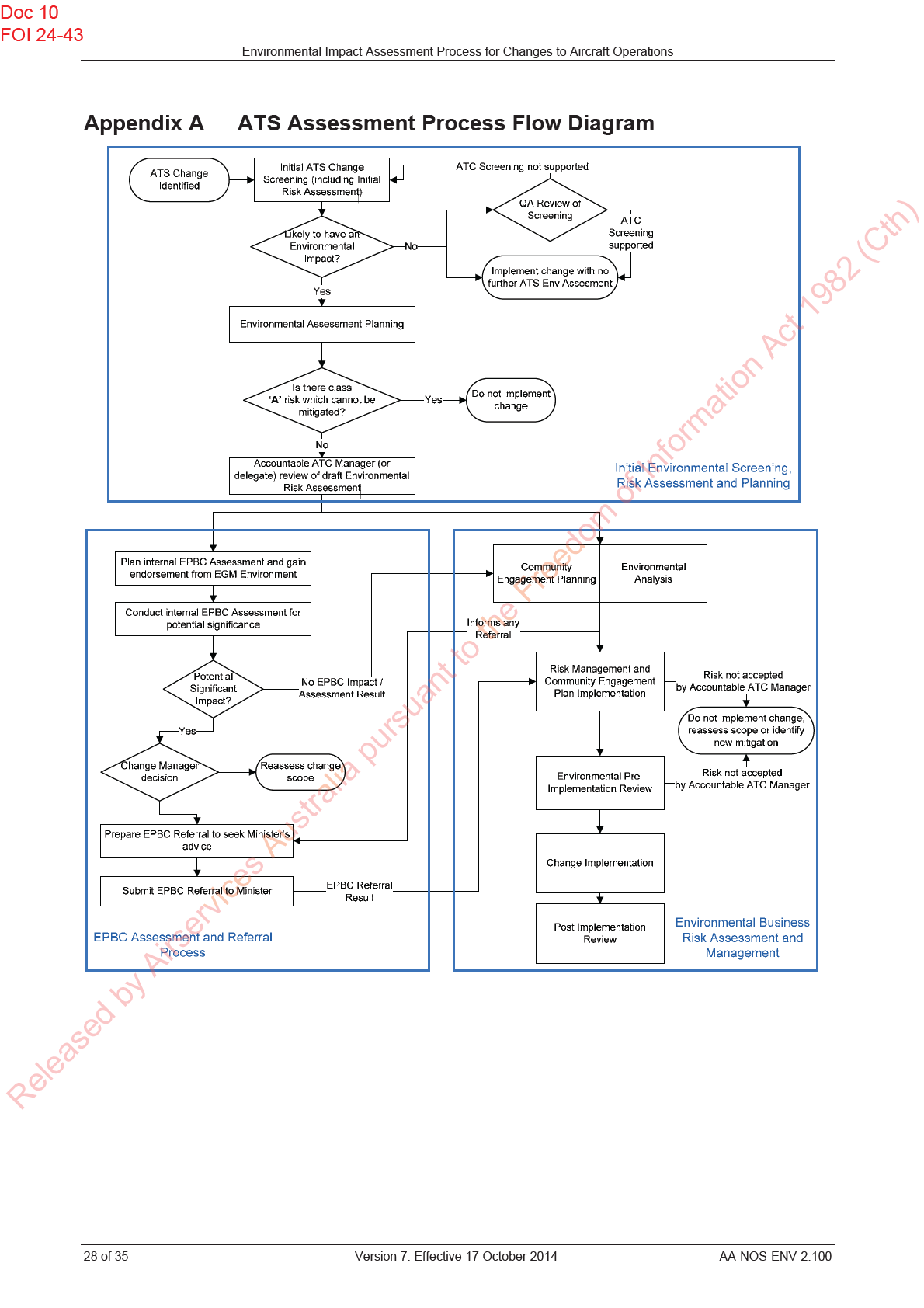
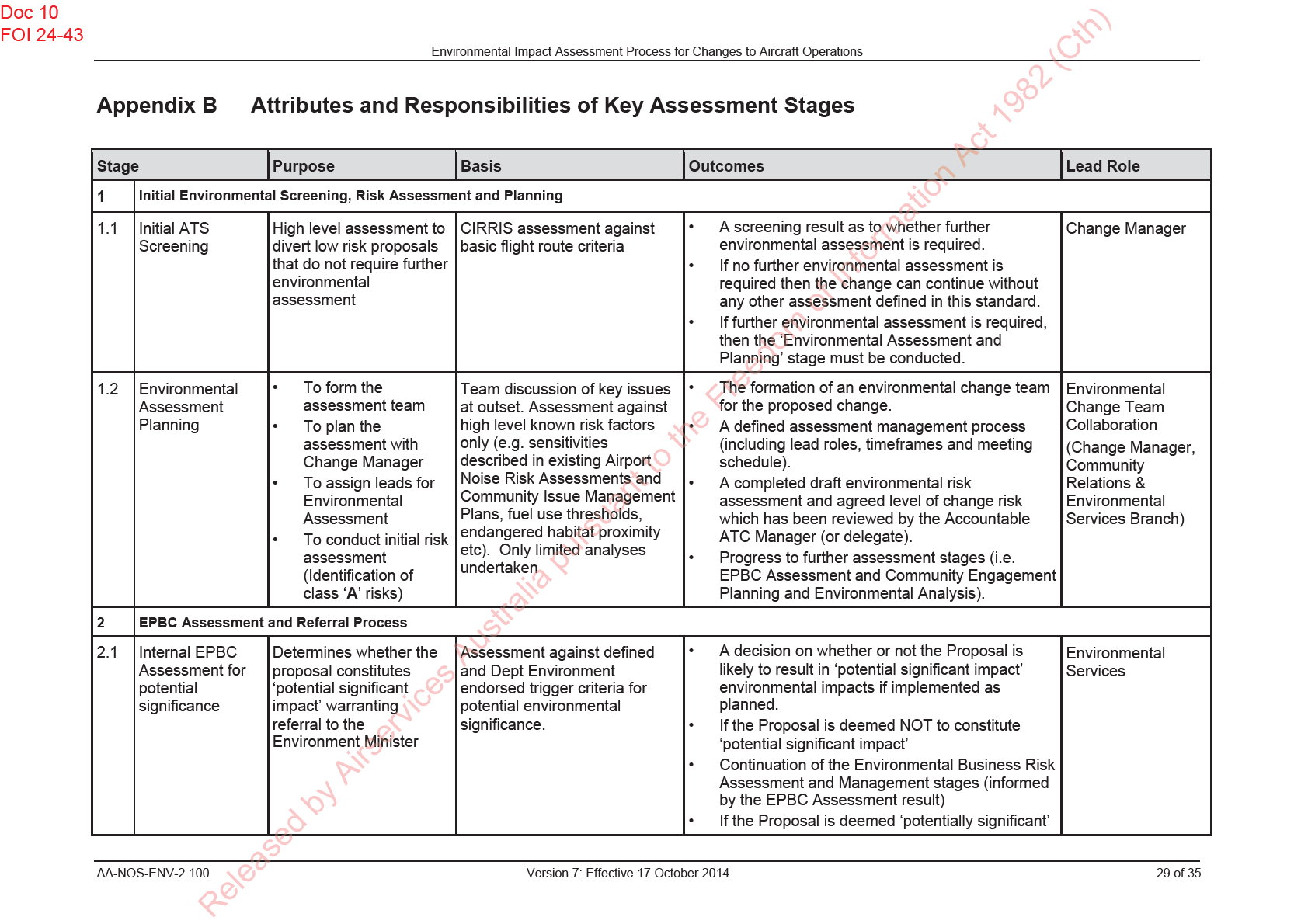
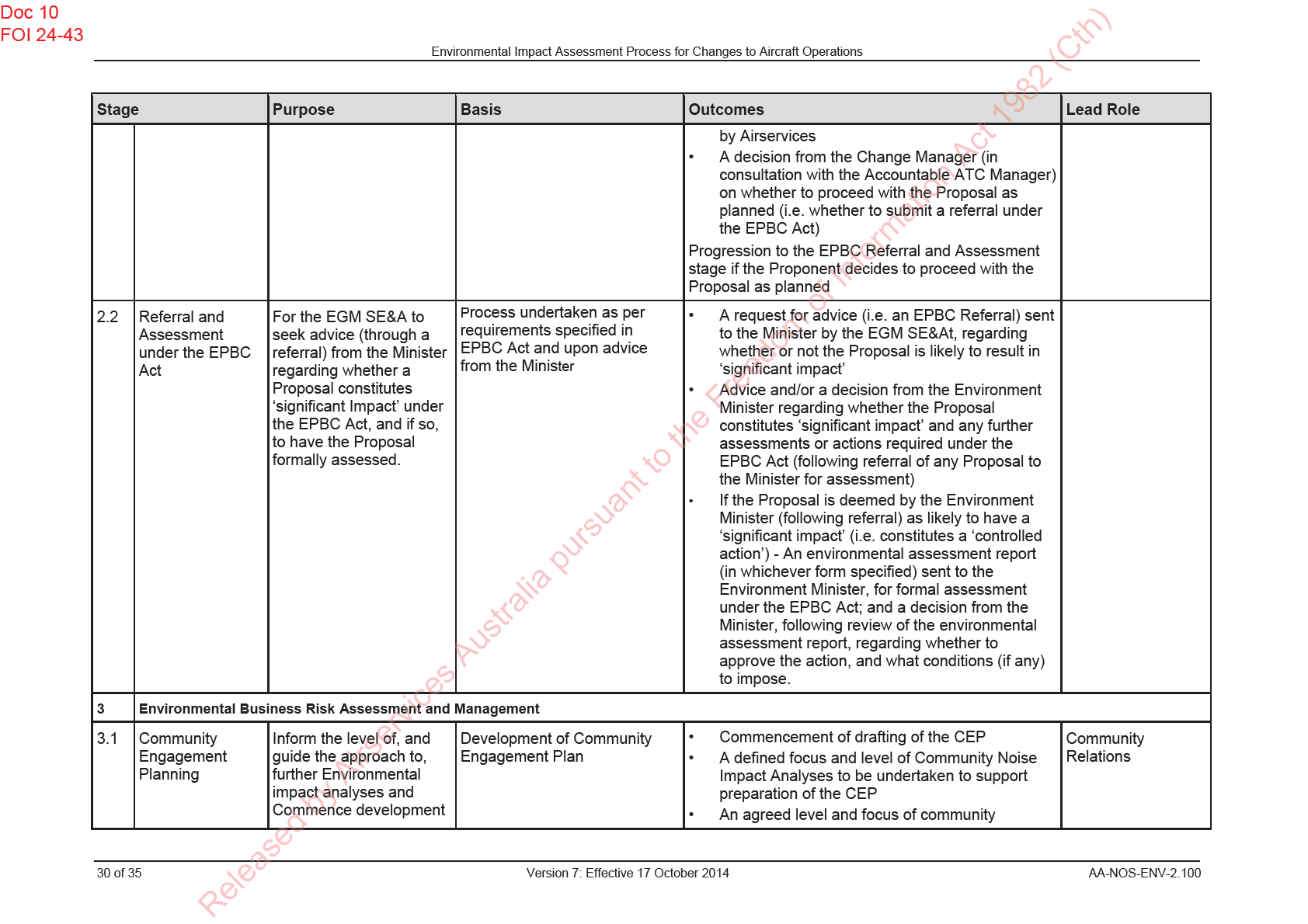
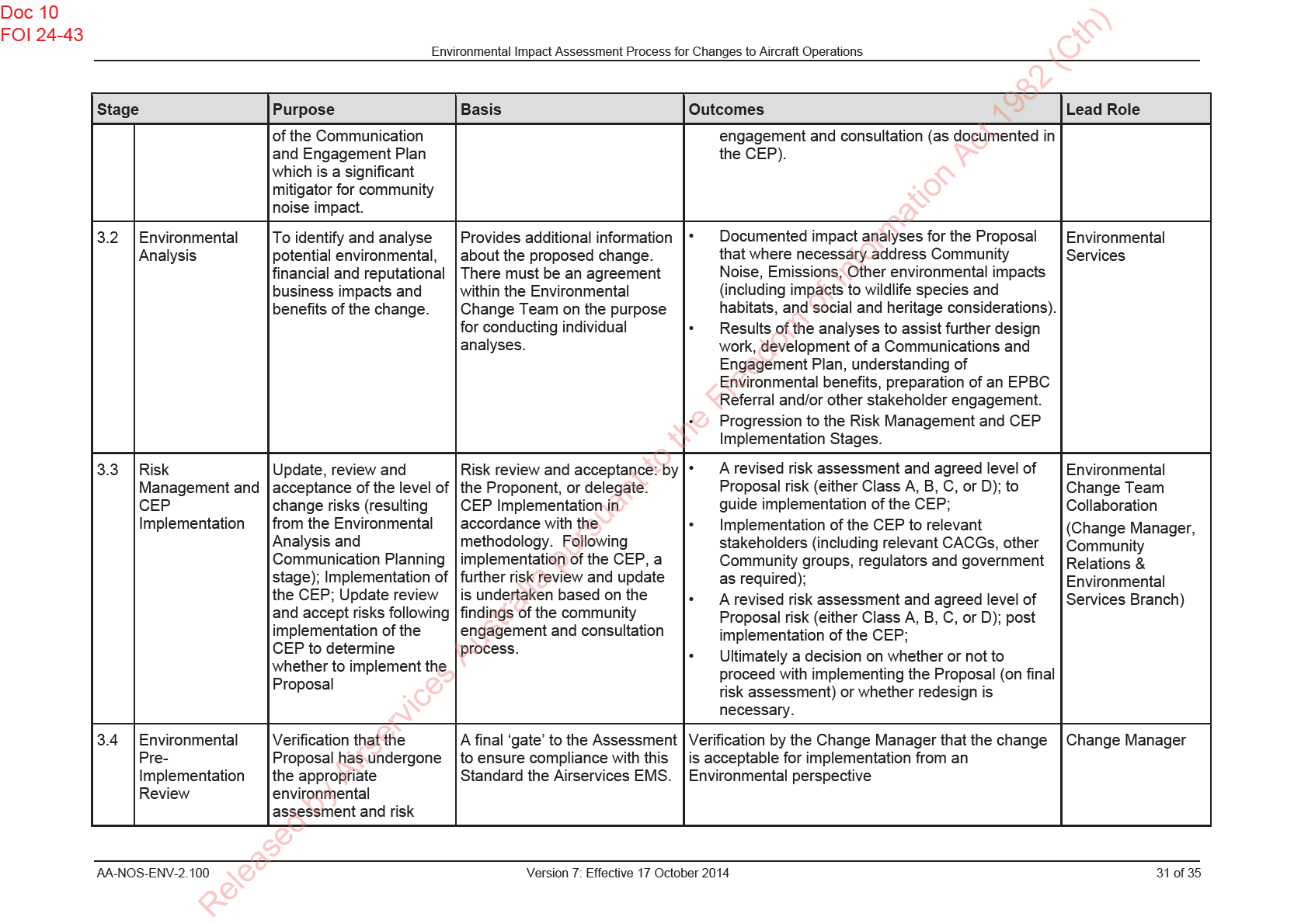
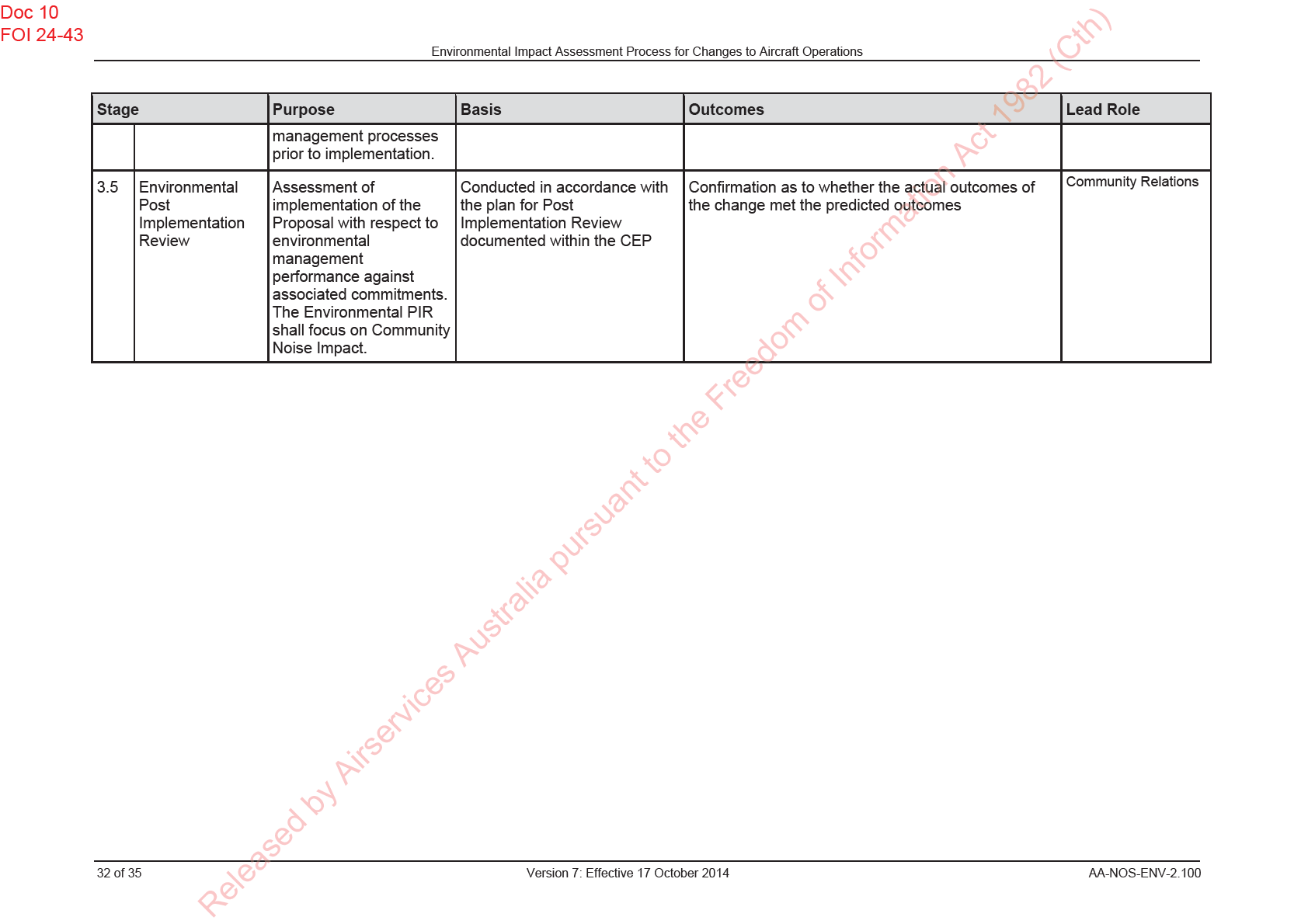
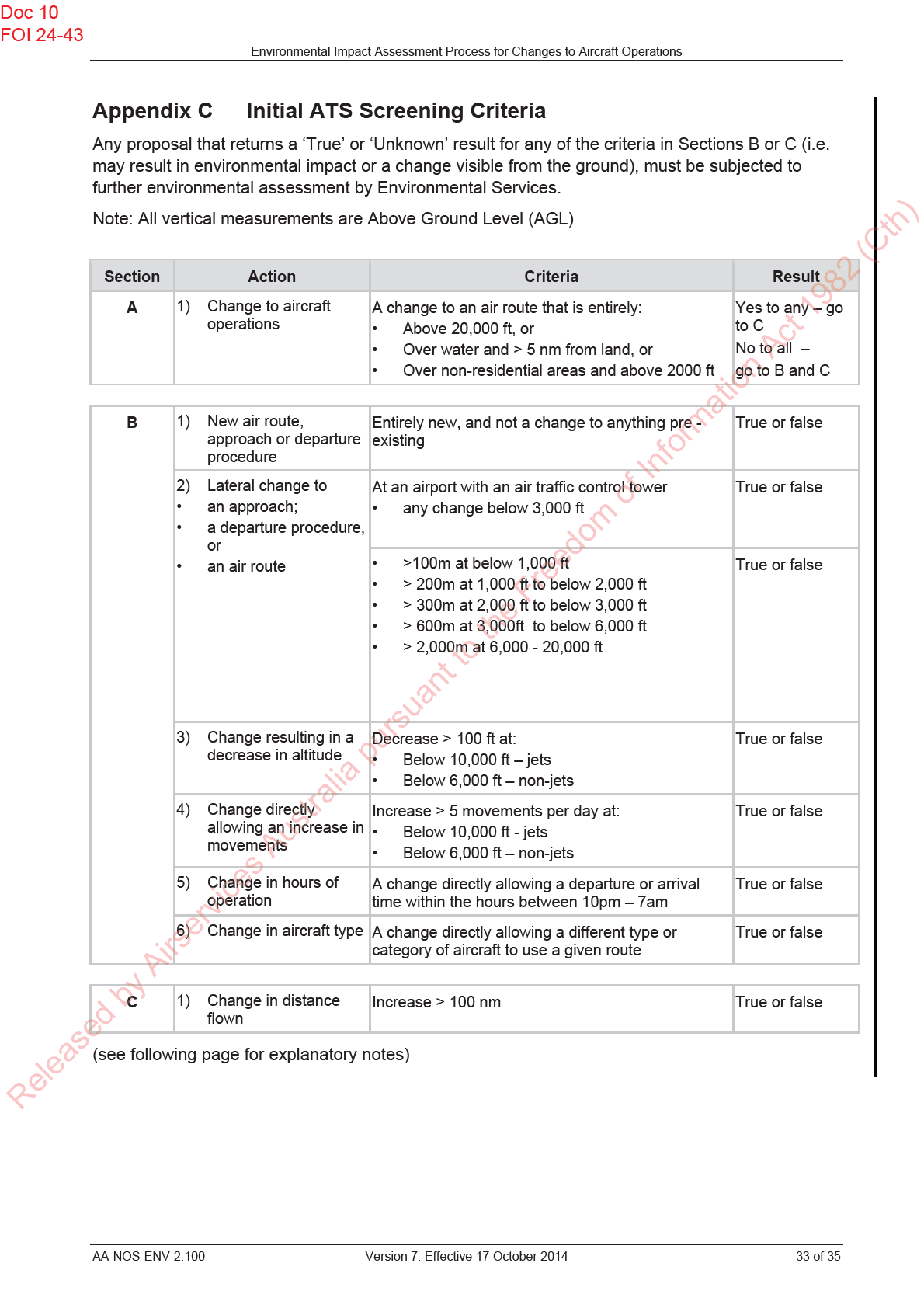
Doc 10
FOI 24-43
Environmental Impact Assessment Process for Changes to Aircraft Operations
Explanatory notes:
1. A change is any Airservices initiated variation to air traffic management
practices that may involve a change to aircraft operations. Changes include, but
are not limited to:
A new, or amendment to an existing, instrument approach
A new, or amendment to an existing, flight path or air route
Re-classification of airspace
Change to preferred runways
Change in time of day of operation (e.g. amendments to tower hours of
operation – the time of day that a tower operates may alter the flight
path used by aircraft)
A change that allows use of a flight path/airspace by a different type or
number of aircraft.
2. A tactical decision of an air traffic controller to alter the track of an individual
aircraft does not constitute a Proposal.
3. Residential areas are identified through analysis of aerial photographs and/or
satellite imagery.
4. Screening criteria are designed to fast-track proposals with impacts far below
the thresholds for significance applied to full assessments.
5. After a proposal is self-assessed as “not requiring further environmental
assessment”, the findings are reviewed by the Environmental Services Branch.
6. Screening criteria may only be applied by proponents who have undergone
appropriate training in the use of, and basis for, the criteria.
7. Average traffic levels may be applicable at locations where there is little
variation in movements throughout the year unless specifically excluded in the
table above. Also specifically excluded are those locations that host special
events attracting additional movements such as air shows.
by Airservices Australia pursuant to the Freedom of Information Act 1982 (Cth)
Released
34 of 35
Version 7: Effective 17 October 2014
AA-NOS-ENV-2.100
Doc 10
FOI 24-43
Environmental Impact Assessment Process for Changes to Aircraft Operations
Appendix D
Other Commercial Revenue – explanatory notes
Other Commercial Revenue (OCR), otherwise referred to as ‘Unregulated Revenue’ or
Non-Airways Revenue, relates to the provision of goods or services other than those
which are provided as part of the regulated service that is subject to the Long Term
Pricing Agreement (LTPA) with customers. For the avoidance of any doubt, OCR is a
term applied to account for those activities not funded through airways revenue.
Airservices OCR includes (but is not limited to):
•
provision of charting services and other publications
•
maintenance or provision of navaids under contract
•
provision of air traffic services under contract (e.g. for Solomon Islands and
Nauru)
•
delivery of training and
•
funds we receive for official development assistance (aid) activities.
For further information on OCR, refer to the following documents:
•
C-PROC0194
•
MI-0205
by Airservices Australia pursuant to the Freedom of Information Act 1982 (Cth)
Released
AA-NOS-ENV-2.100
Version 7: Effective 17 October 2014
35 of 35













